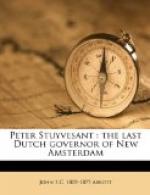* * * * *
The above memorial was signed by ninety-four of the most prominent citizens of New Amsterdam. One of these signers was the governor’s son. All our readers will perceive that the situation of the governor had become one of extreme difficulty. A fleet and army of great strength for the time and the occasion were before him. This force held in reserve the whole military power of New England. The civic officers and citizens of New Amsterdam, headed by the governor’s own son, were loud in their remonstrance against any defence, and were almost in a state of mutiny.
The condition of the city was such that the idea of standing a siege was not for a moment to be thought of. Along the banks of the North and East rivers, the village, for the little cluster of three hundred houses was but a village, was entirely exposed. Upon the land side, running from river to river, there was a slight fence composed of old and decayed palisades, which scores of years before had been a protection against the savages. In front of this fence there were the remains of a storm-washed breastwork, about three feet high and two feet wide.
The crumbling fort was pronounced by all to be untenable. It was originally constructed as a retreat from the savages, who could only assail it with arrows and hatchets and a few musket balls. It was surrounded by an earthen rampart, about ten feet high and three or four feet thick. In all, there were twenty-four cannons within the enclosure, which was unprotected by any ditch or palisades. In the rear, where the throngs of Broadway now press along, there was a series of forest-crowned eminences whose solitary summits were threaded by an Indian trail. These hills commanded the fort. From their crests the soles of the feet, it was said, of those walking in the squares within, could be seen. There were not five hundred pounds of powder in store fit for use. The gunners declared that a few hours of fighting would exhaust it all. The stock of provisions was equally low, and there was not a well of water within the fort.
It is probable that the majority of common soldiers, in almost any regular army, is composed of dissolute worthless men. There are but few persons but the lost and the reckless who will enlist to spend their days in shouldering a musket. A young man of good character can do better than convert himself into a part of such a military machine. The garrison at New Amsterdam was composed of the off-scouring of Europe. They were ready to fight under any banner which would pay them. They were eager for the conflict with the English. At the first volley they would throw aside their guns and join the English in the plunder. One of them was heard saying to an applauding group:




